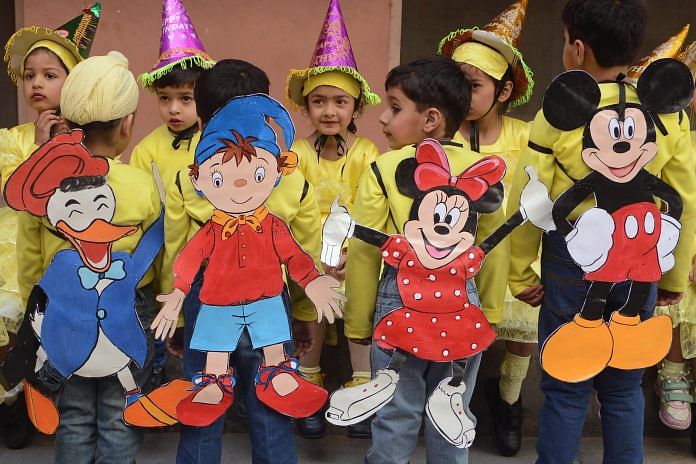Punjab becomes first state to start pre-primary classes in all 13,000 of its govt schools, but anganwadi workers fear this will take away their jobs.
On Children’s Day, quietly, Punjab became the first state in India to start pre-primary classes in all its government primary schools. About 13,000 schools will now admit children between the ages of three to six years in nursery and kindergarten classes.
However, anganwadi workers have protested strongly, saying their jobs are under threat, because their “target group” under the Integrated Child Development Services (ICDS) is being shifted to schools.
The pre-primary classes have been named khed mahal (play palace), and teachers and shiksha sahayaks are busy going door to door in villages, asking parents to send their tiny tots to school. Almost 1.5 lakh students have already enrolled, and the government hopes the number will rise to 3.5 lakh by the admission deadline, 30 November. Surprisingly, there has been no opposition to the move from the highly unionised primary school teachers, who will have to do extra work for no extra pay.
The move has been in the pipeline since 25 September, when it was approved by the state cabinet. It comes in the wake of falling admissions in government schools, with parents preferring private schools, as well as the abysmal exam results of government school students.
Significance of the move
The Right to Education Act provides for free education between six to 14 years of age, but pre-primary education is not part of it; it is stated in the Directive Principles of State Policy, which are desirable, not binding.
Maharashtra and Rajasthan have introduced pre-primary classes in some districts, but Punjab education secretary Krishan Kumar said “we are the first state to introduce these in all our primary schools”.
School education minister Aruna Chaudhary said “everything would be free of cost”, but in a cash-starved state like Punjab, where is the money for this project coming from?
“Apart from Rs 30 crore, which will be spent on the material and books for these children, the project will run on the funds already available for school education. The school buildings remains the same, the teachers remain the same,” Kumar said.
“We will try to provide mid-day meals and uniforms in the coming months,” he added.
Teachers’ support
Government primary school teachers are actually supporting the venture. Between 2011 and 2016, the number of students in government primary schools dropped to 9.5 lakh from 16 lakh, while the number of teachers has remained the same at 48,000.
Hundreds of teachers have little or no work – there are 47 schools with less than five students, and in 15 of them, there are less than three students, leading the government to announce the merger of these schools with nearby schools.
“Teachers realised that if they want to justify their posts, they would have to ensure that students come to government schools, and quality education is provided,” Kumar said.
Anganwadi workers’ ire
On 24 October, thousands of anganwadi workers and helpers tried to gherao Chief Minister Captain Amarinder Singh’s residence in Patiala.
“Anganwadi workers and helpers in Punjab are among the lowest paid in India. This move will take away our jobs. We will continue to protest till the decision is reversed,” said Usha Rani, national president of the Anganwadi Workers and Helpers Federation.
There are almost 27,000 anganwadi centres in Punjab, run under the ICDS. Their job is to take care of children between 0-6 years of age. Each anganwadi has a woman worker and a helper. The centres provide supplementary nutrition to pregnant and nursing mothers and children between six months to three years of age, and pre-school education to children between three to six years of age. Almost 9.5 lakh children and three lakh women are registered in these centres.
The education department has made an offer to anganwadi workers to complement its efforts in running pre-primary classes. “Out of the 27,000 anganwadis, almost one third (7,800) are already running within the premises of primary schools. We have offered that children can be registered concurrently,” said Devinder Boha, the nodal officer for the implementation of the programme.
But anganwadi workers are not impressed with the offer. “Registering a child at two places is cheating. We are not ready to believe anything that the education department officials now say,” said Usha Rani.




Comment:There should not be any pre primary in place of Anganwary centre .And if it is happened in anyway Government have to lose the both.So anyone does not have the right to play with the future of 3-6 years age children.
Pre primary Classes in Govt schools is a welcome move. We are Demanding in all states such arrangements. Anganwadi workers can be trained and upgrade as Pre Primary Teachers. Their jobs should be protected.
– N.Narayana, National Vice-president,
School Teachers Federation of India (STFI).
The Anganwadi centres if entrusted for providing supplimentary nutritious food for pregnant & nursing mothers would be the best job.